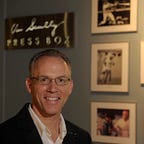Karl Spooner in a classic tale of great expectations
By Mark Langill
You might not recognize the smiling Brooklyn Dodger ballplayer, standing in front of a chalkboard message touting March 1 and the beginning of spring training in 1955. With the passage of time, I look at this photo like a painting in a gallery, so many storylines with just a simple pose.
The player is Karl Spooner, who compiled a lifetime 10–6 record and 3.09 ERA in 31 games with the Dodgers. His arrival at Dodgertown in Vero Beach brought the most fanfare, thanks to his sensational debut at the end of the 1954 season.
The 1954 Dodgers, under first-year manager Walter Alston, were on their way to a second-place finish in the National League when Spooner made his Major League appearance against the rival New York Giants on September 22. Spooner loaded the bases in the first inning and a relief pitcher named Tom Lasorda was dispatched to the bullpen, but he wouldn’t be needed. Spooner escaped the early jam and cruised to a 3–0 shutout. Spooner struck out 15 batters, including six in a row in the seventh and eighth innings. It was the most strikeouts by a pitcher in his first game, surpassing the 13 strikeouts by the Giants’ Cliff Melton in 1937.
Four days later, Spooner struck out 12 batters in a 1–0 victory over the Pittsburgh Pirates. The 27 strikeouts in two games set a National League record and were one shy of Bob Feller’s MLB record of 28 strikeouts.
For Brooklyn Dodger fans, the “Wait ’til next year!” mantra was accompanied by a wistful chorus of “We should have had Spooner sooner!” The Dodgers finished the season at 92–62, five games behind the Giants.
During the winter, the 23-year-old Spooner was the toast of the town in his native Oriskany Falls, a village in central New York, as baseball’s new star received a parade in his honor. The photographs of Spooner in a suit and bow tie signing autographs for a crowd of youngsters resemble a Norman Rockwell painting.
The first days of spring training in 1955 focused on how many wins and strikeouts Spooner could compile in a full season. But reality set in after the Dodgers started the exhibition games. Something was wrong with Spooner’s arm.
There are different theories of how Spooner hurt himself. One was he didn’t get enough time to prepare when Johnny Podres got knocked out of a spring training start early. Spooner was scheduled to pitch in the fourth inning, but Podres left after the second. Spooner told reporters he felt a pull in his shoulder while striking out Jim Rivera on a curveball. The other theory, not publicized at the time, was Spooner hurt himself earlier while pitching during a photo shoot with Life Magazine.
The Dodgers started the regular season without Spooner, but he wasn’t missed as Brooklyn won its first 10 games and roared to a 22–2 start, the best in franchise history. Spooner didn’t make his first start in 1955 until May 15 at Cincinnati. He lasted 13 batters in an 11–4 loss to the Reds, allowing four runs on five hits with two walks and one strikeout.
Spooner’s next appearance was a start 20 days later in the second game of a doubleheader against the Cardinals at Ebbets Field. Spooner fared better, getting a no-decision after four runs (one earned) on six hits in four innings with two walks and six strikeouts.
The rest of Spooner’s season was a mixed bag: June (2–0 record, 1.88 ERA), July (0–3, 6.51), August (4–1, 2.35) and September (2–1, 2.08). He struck out 78 batters and walked 41 in 98 2/3 innings.
In the 1955 World Series, the Dodgers lost the first two games of the Fall Classic at Yankee Stadium, but won the next three at Ebbets Field. One game away from the first championship in Dodger history, Alston decided to give the ball to Spooner, who had pitched three scoreless innings of relief in the second game.
Spooner didn’t get any breaks in the first inning at Yankee Stadium. He faced six batters and was gone after allowing five runs on four hits, the final blow a three-run home run by Bill Skowron. The Dodger bullpen blanked New York over the final 8 2/3 innings, but the Yankees won the game, 5–1.
The next day, Podres came to the Brooklyn rescue with a 2–0 shutout in the deciding Game 7, a victory that elevated the 23-year-old lefty to folk-hero status he would enjoy the rest of his life.
As for Spooner, he never again pitched in the Majors. In 1956, injuries limited him to four games at Triple-A St. Paul. Spooner was selected by the St. Louis Cardinals in the minor league draft after the 1957 season. He retired after spring training in 1959 due to arm trouble.
After baseball, Spooner moved his family from New York to Vero Beach and he eventually was a packing-house manager for the Haffield Citrus Corporation. He passed away of cancer at age 52 in 1984.
In 2003, the Dodgers called up a rookie pitcher in September and gave him a starting assignment on his 20th birthday at Arizona against future Hall of Fame left-hander Randy Johnson. A 4–1 victory by Edwin Jackson in his September 9 debut prompted broadcaster Vin Scully recall the first two starts of a Brooklyn rookie in 1954. At the team bus, Scully told Jackson about the marvelous debut of a young player named Karl Spooner. For Jackson, it was a time for celebration. Scully didn’t tell the rookie how the Spooner baseball story ended.
